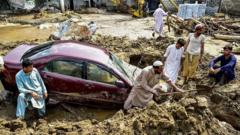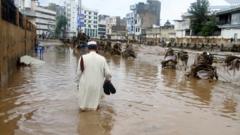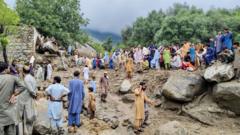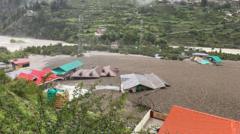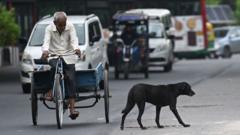As India grapples with soaring temperatures that threaten lives and economic stability, we explore how locals in the hottest areas are adapting to a new reality.**
Surviving the Heat: Life in India's Hottest Regions**

Surviving the Heat: Life in India's Hottest Regions**
Residents of India face extreme heat waves, with temperatures nearing 50 degrees Celsius, leading to significant shifts in daily routines and livelihoods.**
In India, blistering heat waves have settled over much of the country, with daytime temperatures soaring close to 50 degrees Celsius (121 degrees Fahrenheit) in some regions. This extreme heat poses risks to the vast population of 1.4 billion, as three quarters of them are threatened by potentially debilitating heat.
In response to these unrelenting conditions, inhabitants of these regions must adapt their daily lives to survive. For many, the concept of air conditioning remains out of reach, making the scorching heat a constant companion. With outside work being the norm, not working under the sun equates to not being able to eat, heightening the urgency for adaptation.
To gain further insights into how residents navigate these extreme temperatures, a field visit was made to Sri Ganganagar, a city located in the desert state of Rajasthan. This exploration sheds light on the new rhythms of life that have surfaced in a nation grappling with climate changes that are unfolding at a pace faster than the global average.
During the visit, it was recorded that daily temperatures reached an alarming 47 degrees Celsius (117 degrees Fahrenheit) and fluctuated up to 49 degrees Celsius the following day. The rising humidity, which has been a growing trend over the past decade, further exacerbates discomfort and complicates coping mechanisms.
As the impacts of climate change become ever more pronounced, observing the lifestyles of those living in the most affected areas provides critical context. Their resilience and adaptability reveal insights not only about survival in harsh climates but also about the broader implications of climate change affecting livelihoods, economic productivity, and public health in India.
In response to these unrelenting conditions, inhabitants of these regions must adapt their daily lives to survive. For many, the concept of air conditioning remains out of reach, making the scorching heat a constant companion. With outside work being the norm, not working under the sun equates to not being able to eat, heightening the urgency for adaptation.
To gain further insights into how residents navigate these extreme temperatures, a field visit was made to Sri Ganganagar, a city located in the desert state of Rajasthan. This exploration sheds light on the new rhythms of life that have surfaced in a nation grappling with climate changes that are unfolding at a pace faster than the global average.
During the visit, it was recorded that daily temperatures reached an alarming 47 degrees Celsius (117 degrees Fahrenheit) and fluctuated up to 49 degrees Celsius the following day. The rising humidity, which has been a growing trend over the past decade, further exacerbates discomfort and complicates coping mechanisms.
As the impacts of climate change become ever more pronounced, observing the lifestyles of those living in the most affected areas provides critical context. Their resilience and adaptability reveal insights not only about survival in harsh climates but also about the broader implications of climate change affecting livelihoods, economic productivity, and public health in India.


